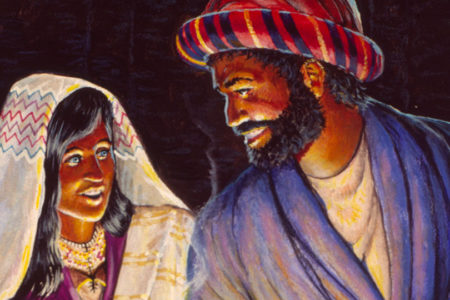Ruth and the Messiah
The charming little account contained in the Book of Ruth has all the interest-catching elements of an absorbing short story. The reader is exposed to a plot containing elements of tragedy, conflict, characterization, and resolution. The action moves to a truly satisfying “they lived happily ever after” conclusion. The reader of this enchanting idyll may, therefore, be a little let down by the last five verses of the book, which seem to have been added as a pedantic afterthought. These verses comprise a genealogical list of ten generations—six before Boaz and Ruth and three following the happy couple.
Now these are the generations of Perez: Perez begot Hezron, And Hezron begot Ram, and Ram begot Amminadab, And Amminadab begot Nahshon, and Nahshon begot Salmon, And Salmon begot Boaz, and Boaz begot Obed, And Obed begot Jesse, and Jesse begot David (Ruth 4:18–22).
Why would this seemingly irrelevant roster be appended to such a beautifully engaging and romantic tale? Are the higher critics correct in seeing these verses as the later appendage of an editor trying to make the book a bit more official as a court document of David? Because all of God’s Word is “profitable” (see 2 Tim. 3:16–17), we must reflect further on what this conclusion of the book is communicating to us.
When we begin reading the New Testament, we are confronted with a similar shock. Instead of immediately launching into the account of Jesus’ birth, Matthew serves us 17 verses, containing nearly 50 names, covering a period of almost 2,000 years (Mt. 1:1–17)! Many readers admittedly skip over this register of mostly unfamiliar characters so they can get to the good stuff in verse 18 and following. By doing so, however, they miss some fascinating truths. As a matter of fact, the genealogies concluding Ruth and beginning Matthew are strikingly similar. It even appears that Matthew was consciously using the end of Ruth in his own register of Jesus’ ancestors. What is the Word of God teaching here?
One of the striking facets of Jesus’ genealogy in Matthew is its inclusion of women, a practice uncharacteristic of Jewish genealogies. No less than four are mentioned, three by name and one by her relationship to her husband. The first is Tamar (Mt. 1:3), who gave birth to Perez by Judah (see the account in Gen. 38). The second is Rahab (Mt. 1:5), who gave birth to Boaz by Salmon (Ruth 4:21). The third is Ruth (Mt. 1:5), who gave birth to Obed by Boaz (Ruth 4:21). The fourth is Bathsheba (“her that had been the wife of Uriah,” Mt. 1:6), who gave birth to Solomon by David (2 Sam. 12:24).
The following table helps to visualize better the parallels between the two genealogies:
| Matthew 1:3–6 | Ruth 4:18–22 |
| “Judah begot Perez … of Tamar” (1:3) | “Perez” (4:18) |
| “Salmon begot Boaz of Rahab” (1:5) | “Salmon” (4:20) |
| “Boaz begot Obed of Ruth” (1:5) | “Boaz” (4:21) |
| “David, the king, begot Solomon of her that had been the wife of Uriah” (1:6) | “David” (4:22) |
The purpose of the genealogy in Ruth is to show that Ruth’s husband Boaz was a descendant of Judah, the man who fathered the tribe of the King-Messiah (Gen. 49:10). Furthermore, it indicates that Ruth was the great-grandmother of David, the man God chose to be king (see 1 Sam. 16:12) and ancestor of the Messiah.
The purpose of Matthew’s genealogy is to record the messianic line down to Joseph, who Matthew is careful to show was not the physical father of Jesus, but his legal, adoptive father: “And Jacob begot Joseph, the husband of Mary, of whom was born Jesus, who is called Christ” (Mt. 1:16).
Further reflection on Matthew’s inclusion of these four women presents some other striking paradoxes. Not only did he include women in the ancestry of the Messiah—an uncommon practice of the times—but there were other negative aspects of these women that stand out. They were all Gentiles: Tamar and Rahab were Canaanites; Ruth was a Moabite; and Bathsheba was most probably a Hittite. As if that were not enough, each of these women had some shadow over her behavior or background. Tamar and Rahab had been prostitutes; Bathsheba had committed adultery; and Ruth was a member of a people who had been ancient enemies of Israel and were excluded (at least the men) from the congregation of the Lord for ten generations (Dt. 23:3).
Thus, Matthew included four women who were also Gentiles and who had some taint on their lives. If you or I had written Jesus’ genealogy, we would perhaps have been tempted to omit these distaff members from the list. But Matthew, without apology or fear of embarrassment, portrayed them for all to read and recognize. Is there a reason for this inclusion?
I believe there is, and I further believe that reason also relates to why the little story of Ruth is included in the Bible. Ruth was a Gentile woman who was the great-grandmother of the greatest king of Israel—David. This indicates God’s love and grace to this dear woman. What a privilege to be included in the ancestry of the “sweet psalmist of Israel” (2 Sam. 23:1), in spite of the fact that she had so many strikes against her.
So it is with the larger picture of the four women included in the genealogy of Jesus by Matthew. Perhaps what the Lord is showing to us here at the beginning of the New Testament is that:
- Jesus is also for women, not just for men. This blessed truth, echoed so often in the Gospels (they were last at the cross and first at the tomb), ought to encourage every feminine follower of the Savior.
- Jesus is also for Gentiles, not just for Jews. Their inclusion here presaged the eventual inclusion of those “other sheep” (Jn. 10:16) that Jesus would call, who are outside the fold of Israel.
- Jesus is also for sinners, not just for the righteous. Didn’t Jesus Himself state this very truth in Matthew 9:13b, “I am not come to call the righteous, but sinners to repentance”?
I can imagine an aged Ruth called one happy day to the home of her grandson, Jesse. There her dim eyes beheld a red-headed newborn—the eighth son of Jesse. Did she recognize that this little one would be the ancestor of the Messiah—He who would be the “Lion of the tribe of Judah” (Rev. 5:5) and who would one day take the throne of His father David (Lk. 1:32)? She had already experienced redemption by a goel—her beloved redeemer, Boaz. Perhaps she recognized that an even greater redeemer would come some day, from her very own seed.
Surely she must have been extremely grateful that she, a Moabite woman, had been privileged to be included in the line of the Messianic King. This, my dear reader, is what is conveyed to us by that list of ten names in Ruth 4:18–22.








